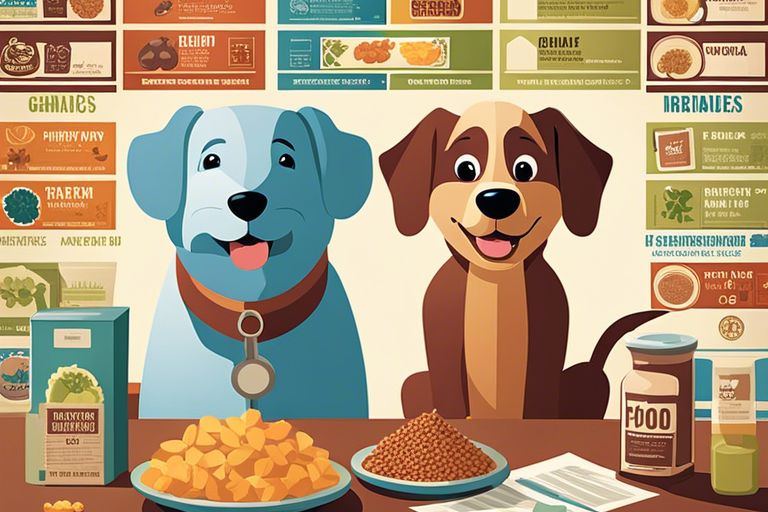Welcome to our informative blog post on understanding pet food labels. It is not uncommon for pet owners to feel overwhelmed by the extensive and sometimes confusing ingredient lists and guarantees found on pet food packaging. However, it is crucial for the health and wellbeing of our beloved pets that we understand exactly what is in their food. In this blog post, we will break down the components of pet food labels and provide you with the knowledge and confidence to make informed decisions about what you are feeding your furry friends.
Pet food labels can often be misleading and difficult to interpret, but with the right information, you can become an empowered consumer and ensure that your pet is receiving the best nutrition possible. We will discuss the importance of understanding ingredient lists and guarantees on pet food labels, and provide you with the knowledge to make the best choices for your pet’s dietary needs.
Key Takeaways:
- Understanding ingredient lists: Pet food labels list ingredients in order of weight, so pay attention to the first few listed to understand the main components of the food.
- Decoding guarantees: Guarantees such as “crude protein” and “crude fat” refer to minimum levels, not exact amounts, so be sure to look for specific percentages.
- Avoiding fillers: Look for whole, named animal proteins such as chicken or beef as the first ingredient, and avoid foods with vague terms like “meat by-products.”
- Misleading marketing terms: Phrases like “all-natural” or “holistic” are not regulated and may not indicate higher quality, so focus on the actual ingredients listed instead.
- Reading beyond the front label: Take the time to read the full ingredient list, not just the marketing claims on the front of the package, to get a true understanding of what you’re feeding your pet.
- Considering individual pet needs: Different pets may require different nutritional profiles, so consult with your veterinarian to determine the best food for your specific pet’s needs.
- Importance of quality sourcing: Look for pet foods made with high-quality, whole food ingredients and avoid those with artificial additives and fillers for better overall nutrition.
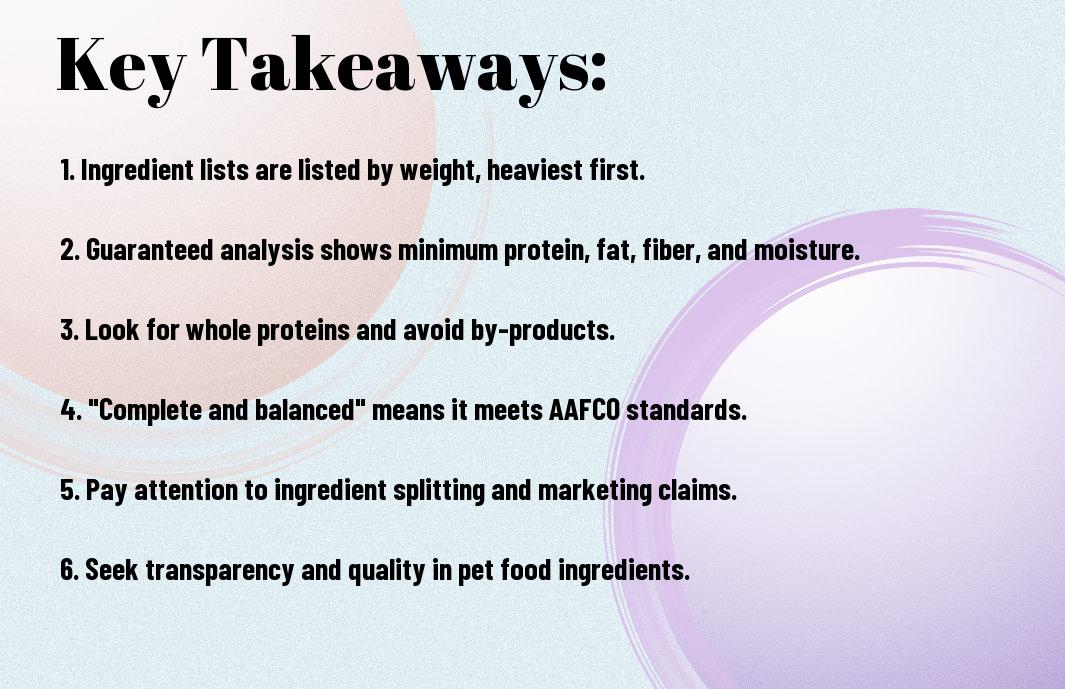
Understanding Ingredients Lists
Assuming you have ever glanced at the back of a pet food bag, you may have been overwhelmed by the long list of ingredients. Understanding what these ingredients mean and how they are listed can be crucial in making informed decisions about your pet’s nutrition.
Order of Ingredients and What it Tells You
Lists of ingredients on pet food labels are required to be listed in descending order by weight. This means that the first few ingredients listed make up the majority of the product. So, when you see a protein source like chicken or beef listed as the first ingredient, it indicates that the product is likely high in animal-based protein, which can be beneficial for your pet’s health. On the other hand, if you see fillers like corn or soy listed as the first ingredient, it may indicate a lower-quality product that is heavy on carbohydrates and lacking in essential nutrients.
Identifying High-Quality Ingredients
Order of ingredients can give you a good idea of the overall quality of the pet food. Look for whole protein sources like chicken, turkey, or fish as the first ingredient, as these provide essential amino acids and are more easily digestible for pets. Avoid products that list vague ingredients like “meat by-products” or “animal digest,” as these can be of lower quality and may not provide the nutrients your pet needs. With the primary sources of protein, it’s also important to look for wholesome carbohydrates, such as brown rice or sweet potatoes, and beneficial fats from sources like salmon oil or flaxseed.
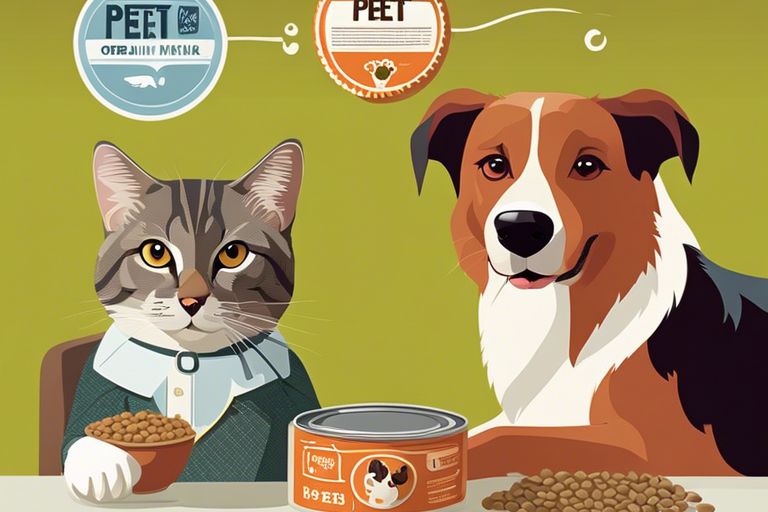
The Nutritional Adequacy Statement
After understanding the ingredient list, the next crucial piece of information on a pet food label is the nutritional adequacy statement. This statement will tell you whether the food is complete and balanced for the intended life stage of your pet. It will also specify if the food meets the standards set by the Association of American Feed Control Officials (AAFCO). For more in-depth information on decoding pet food labels, check out our article on Demystifying the Dog Food Label.
Decoding Life Stage Appropriateness
To ensure your pet is receiving the proper nutrition, it’s crucial to understand whether the food is appropriate for their life stage. There are specific nutritional requirements for puppies and kittens, adult dogs and cats, and senior pets. The nutritional adequacy statement will clearly state which life stage the food is suitable for, providing you with the information needed to make an informed decision for your pet’s diet.
Understanding Animal Feeding Tests vs. Formulated Foods
On the pet food label, you may come across information about whether the product has undergone animal feeding tests or is formulated to meet AAFCO standards. Foods that have undergone animal feeding tests have been fed to animals in a controlled setting to ensure they meet the necessary nutritional requirements. Formulated foods, on the other hand, are designed based on the established nutrient profile without being tested on animals.
When choosing pet foods, it’s essential to consider both types of products and understand the implications of each. Both animal feeding tests and formulated foods have their own merits, and it’s important to select the option that aligns with your pet’s specific nutritional needs and your personal values as a pet owner.
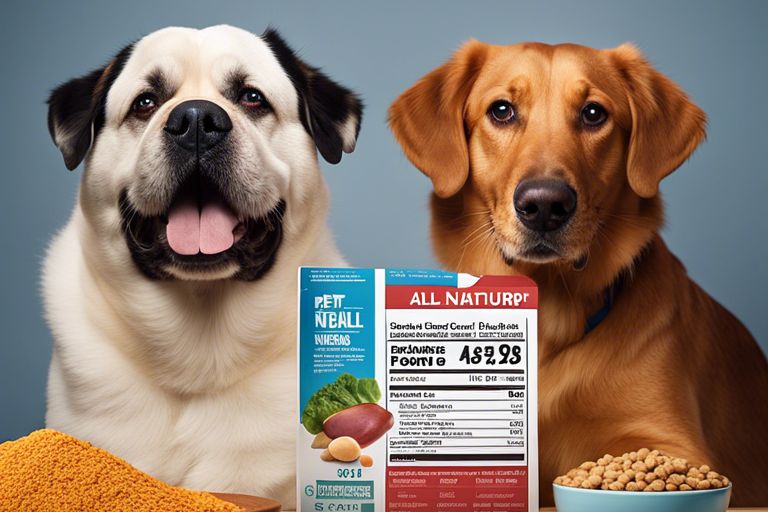
Comprehending Guaranteed Analysis
Keep in mind that the guaranteed analysis on pet food labels provides minimum or maximum percentages of key nutrients, such as protein, fat, fiber, and moisture. These percentages give you an idea of the nutritional content of the food and can help you make informed decisions about what to feed your pet. It’s important to pay attention to these values, as they can vary significantly between different brands and types of pet food.
Reading Nutrient Guarantees
Guaranteed analysis can sometimes be confusing to interpret, but it’s an essential part of understanding the nutritional composition of pet food. Look for the minimum or maximum percentages of protein, fat, fiber, and moisture, as well as any other important nutrients for your pet’s specific needs. This information can help you compare different products and select the one that best fits your pet’s dietary requirements.
Comparing Different Types of Pet Foods
When comparing different types of pet foods, it’s crucial to consider the guaranteed analysis to understand the nutritional differences between them. Look for variations in protein, fat, fiber, and moisture content, as these can impact your pet’s overall health and well-being. It’s also important to consider any specific dietary needs your pet may have, such as allergies or sensitivities, when comparing different types of pet food.
- The guaranteed analysis can help you determine the nutritional content of each type of pet food.
- Comparing different types of pet foods can help you find the best option for your pet’s specific needs.
Plus, it’s essential to consider any additional nutritional information provided by the manufacturer, such as vitamins, minerals, and other essential nutrients. This information can be helpful in determining the overall nutritional value of the pet food and ensuring that your pet receives a balanced diet.
Recognizing Common Ingredient Classifications
To ensure that you are making informed decisions about your pet’s nutrition, it’s important to understand the common ingredient classifications found on pet food labels. By recognizing these classifications, you can better interpret ingredient lists and make informed choices for your furry friend.
Animal Protein Sources
One of the most important ingredient classifications in pet food is the source of animal protein. High-quality pet foods will list specific animal protein sources such as chicken, beef, or fish. Look for these specific ingredients rather than generic terms like “meat by-products” or “meat meal,” which may not provide the same level of nutritional quality for your pet. It’s important to prioritize animal protein sources as the primary ingredients in your pet’s food, as they offer essential amino acids and nutrients that contribute to your pet’s overall health and well-being.
Grains, Vegetables, and Fruits in Pet Foods
Sources of grains, vegetables, and fruits in pet foods play a crucial role in providing necessary carbohydrates, fiber, and essential vitamins and minerals for your pet. When examining ingredient lists, look for specific grains such as brown rice, quinoa, or oats, as well as recognizable vegetables and fruits like carrots, spinach, and blueberries. These whole food ingredients offer important nutrients and antioxidants that support your pet’s immune system and digestion. Different classifications of these ingredients can have varying impacts on your pet’s overall health and well-being, so it’s important to understand the specific sources of grains, vegetables, and fruits in your pet’s food.
Classifications related to grains, vegetables, and fruits in pet foods can impact the nutritional quality and digestibility of the food. Understanding the specific sources of these ingredients can help you make informed decisions about the best options for your pet’s diet, supporting their overall health and vitality. When examining ingredient lists, look for whole and recognizable sources of grains, vegetables, and fruits to ensure that your pet is receiving the essential nutrients they need for a balanced and nutritious diet.
Evaluating Additives and Preservatives
Now, let’s delve into the important aspect of evaluating additives and preservatives in pet food. Additives and preservatives play a crucial role in ensuring the safety and quality of pet food, but it’s essential to understand the differences between natural and artificial additives, as well as the purpose they serve.
Natural vs. Artificial Additives
Natural additives are derived from sources such as vitamin E, vitamin C, and rosemary extract. These additives are used to provide essential nutrients, enhance flavor, and extend the shelf life of pet food. On the other hand, artificial additives are synthetic substances that are added to pet food for various purposes, including color enhancement, texture improvement, and flavor enhancement. When evaluating pet food labels, it’s important to consider the type and source of additives used, as natural additives are generally preferred over their artificial counterparts due to their safety and nutritional value.
Understanding the Purpose of Preservatives
Natural preservatives, such as tocopherols (a form of vitamin E) and ascorbic acid (a form of vitamin C), are used to prevent oxidation and spoilage of pet food. These natural preservatives help maintain the freshness and quality of the ingredients used in pet food. On the other hand, artificial preservatives such as BHA, BHT, and ethoxyquin are used to extend the shelf life of pet food by inhibiting the growth of bacteria, mold, and yeast. When it comes to preservatives, it’s important to understand the purpose they serve and their potential impact on your pet’s health.
Additives and preservatives play a crucial role in pet food, but it’s important to carefully evaluate their type, source, and purpose to ensure the safety and well-being of your furry friend. Look for natural additives and preservatives in pet food, and consider their nutritional value and potential impact on your pet’s health. By understanding the role of additives and preservatives in pet food, you can make informed decisions when selecting the best nutrition for your pet.
Specialized Diets and Claims
Unlike general pet food, specialized diets are formulated to address specific nutritional needs or health concerns in pets. These can include grain-free, organic, raw, hypoallergenic, and veterinary formulas. Understanding the claims and ingredients in these specialized diets is crucial for pet owners to make informed decisions about their pets’ nutrition.
Grain-Free, Organic, and Raw Diets Explained
The rise in popularity of grain-free, organic, and raw diets for pets has led to a variety of options for pet owners. Grain-free diets are formulated without grains such as wheat, corn, or soy, which can be beneficial for pets with certain food sensitivities or allergies. Organic diets use ingredients that are certified organic, meaning they are free of synthetic pesticides, hormones, and antibiotics. Raw diets consist of uncooked, minimally processed ingredients, which proponents claim closely mimic the natural diet of wild animals. It’s important for pet owners to thoroughly research and understand the nutritional implications and potential risks associated with these diets before making any changes to their pets’ food.
Evaluating Hypoallergenic and Veterinary Formula Claims
Explained Some pet food manufacturers claim that their products are hypoallergenic or veterinary formulas, designed to alleviate common health issues in pets. Hypoallergenic diets are formulated with limited ingredients to reduce the risk of triggering allergic reactions in pets, while veterinary formulas are often recommended by veterinarians to address specific health conditions such as kidney disease, diabetes, or obesity. However, it’s important for pet owners to consult with their veterinarian before switching to these specialized diets, as they may require a proper diagnosis and professional guidance to ensure the best outcome for their pets’ health.
To make a well-informed decision about specialized pet diets, pet owners should carefully evaluate the claims and ingredients in the food labels, as well as consult with a veterinarian to ensure the best nutritional and health outcomes for their pets. Keywords: specialized diets, grain-free, organic, raw, hypoallergenic, veterinary formulas, pet nutrition, pet health
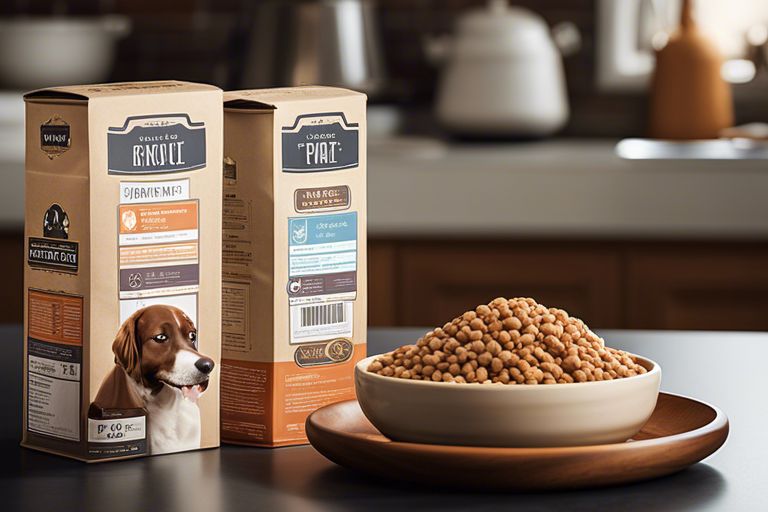
Demystifying Pet Food Labels – Understanding Ingredient Lists And Guarantees
From above discussion, it is clear that understanding pet food labels and ingredient lists is essential for making informed decisions about what to feed our pets. By deciphering the language used on labels and understanding the significance of guarantees, pet owners can ensure that they are providing their pets with high-quality, nutritionally balanced food. It is important to look for specific ingredients, such as meat or meat meals, and to be wary of vague terms like “by-products” or “animal digest”. Additionally, paying attention to the guaranteed analysis can give insight into the nutritional content of the food, helping pet owners to select the best option for their furry friends.
Ultimately, being an educated consumer when it comes to pet food labels can lead to better overall health and well-being for our pets. By taking the time to understand and analyze the information provided on labels, pet owners can make choices that align with their pet’s specific dietary needs and preferences. With these insights, pet owners can confidently navigate the world of pet food and provide their beloved animals with the nutrition they deserve.
FAQ: Demystifying Pet Food Labels – Understanding Ingredient Lists And Guarantees
Q: What information can be found on a pet food label?
A: Pet food labels must include the product name, net weight, guaranteed analysis, ingredient list, feeding guidelines, and the manufacturer’s contact information.
Q: What is the guaranteed analysis on a pet food label?
A: The guaranteed analysis lists the minimum percentages of crude protein and crude fat, and the maximum percentages of crude fiber and moisture in the pet food.
Q: How should I interpret the ingredient list on a pet food label?
A: Ingredients are listed in descending order by weight, so the first ingredients make up the majority of the pet food. Look for whole, recognizable ingredients like chicken, brown rice, and carrots, and be cautious of vague terms like “meat by-products.”
Q: What do terms like “natural” and “holistic” mean on a pet food label?
A: These terms are not regulated and have no standard definition, so they may not provide meaningful information about the quality of the pet food. Look for specific ingredients and a complete nutritional profile instead.
Q: What does the “complete and balanced” statement mean on a pet food label?
A: This statement indicates that the pet food meets the nutritional requirements for a specific life stage as established by the Association of American Feed Control Officials (AAFCO).
Q: Can I trust the expiration date on a pet food label?
A: The expiration date or “best by” date provides a guideline for the freshness and shelf life of the pet food. It’s important to store pet food properly and use it before the expiration date for the best quality and safety.
Q: Are there specific ingredients I should avoid in pet food?
A: It’s best to avoid artificial preservatives, colors, and flavors, as well as fillers like corn and soy. Additionally, some pets may have sensitivities to common allergens such as wheat and dairy.
